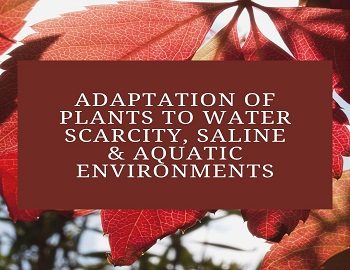Table of Contents
Adaptation of Plants to Water Scarcity, Saline & Aquatic Environments:
What is Adaptation?
It is the development of certain features in an organism in response to particular environment which may improve the chances of its survival. The organisms develop various types of morphological, physiological and behavioural adaptations which enable them to take advantage over their environment successfully for increasing their chances of survival. These special features evolve over a long period of time through the process of natural selection. The ultimate aim of adaptation is to seek food for their survival.
Adaptation of Plants to Water Scarcity:
The plants of hot deserts are adapted to survive in dry conditions of soil and high temperatures. The plants which evade dry conditions are known as ephemerals. These have the following adaptations-
- They have deep tap roots that can reach up to the water table in arid climates as in Prosopis (mesquite), palms, and some species of Acacia.
- Stomata are sunken in Nerium oleander.
- Leaves are deciduous, leathery with waxy cuticle in order to perform low respiration.
- In Cacti, leaves are reduced to spines, and stems are modified into fleshy and spongy structures. Some cacti have expandable stems for storing water and have spreading root systems in the surface layer of the soil.
Adaptation of Plants to Saline Environment:
Halophytes are plants of the saline environment that are adapted to grow in a high concentration of salt in soil or water. They occur in tidal marshes and coastal dunes, mangroves, and saline soils.
- Halophytic plants, under hot and dry conditions, may become succulent and dilute the ion concentration of salts with water which they store in cells of stems and leaves.
- Mangroves which grow in marshy conditions can excrete salts through the salt glands on the leaves. Some mangroves can expel salts from roots by pumping excess salts back into soil.
- Dunaliella species (green and halophytic algae found in hyper saline lakes) can tolerate saline conditions by accumulating glycerol in the cells, which help in osmoregulation.
- Avicennia and Rhizophora (red mangrove) have special adaptations like pneumatophores, prop and stilt roots, and vivipary (seeds germinate while on the tree). The presence of pneumatophores (the respiratory roots) helps to take up oxygen from the atmosphere and transport it to the main roots. Prop and stilt roots in many species of mangroves give support to the plants in the wet substratum. Vivipary permits plants to escape the effect of salinity on seed germination.
Adaptation of Plants to Aquatic Environment:
The plant which remains permanently immersed in water is called hydrophytes. They may be submerged or partly submerged and have the following adaptation-
- They have the presence of Aerenchyma (larger air spaces) in the leaves and petioles which help to transport oxygen produced during photosynthesis and permit its free diffusion to other parts including roots located in anaerobic soil. This tissue also provides buoyancy to the plants.
- Eichhornia (water hyacinth) has the presence of inflated petioles which keep the plants floating on the surface of water.
- Roots are poorly developed or absent in free-floating hydrophytes like Wolffia, Salvinia, and Ceratophyllum.
- Various emergent hydrophytes (having leaves projecting above the water surface) have a continuous system of air passage which helps the submerged plant organs to exchange gases from the atmosphere through the stomata in the emergent organs.









Comments (No)